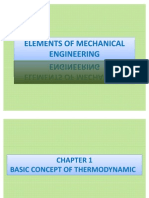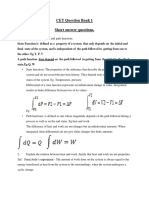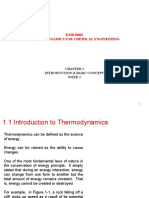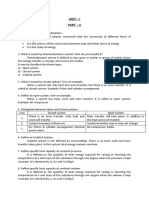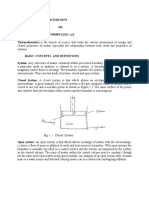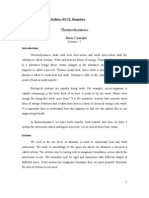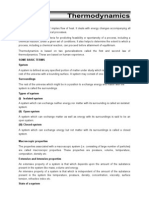Chapter 1: Introduction and Basic Concepts: Macroscopic Temperature Macroscopic Temperature Pressure
Uploaded by
Khan SamiChapter 1: Introduction and Basic Concepts: Macroscopic Temperature Macroscopic Temperature Pressure
Uploaded by
Khan Sami6/22/2010
Chapter 1: Introduction and Basic Concepts
INTRODUCTION
Thermodynamics is the study of energy conversion between heat and mechanical work, and subsequently the macroscopic variables such as temperature, volume and pressure. One of the most fundamental laws of nature is the conservation of energy principle. It simply states that during an energy interaction, energy can change from one form to another but the total amount of energy remains constant. That is, energy cannot be created or destroyed.
2
6/22/2010
Applications in Engineering Systems
1. Air-Conditioning systems 2 Refrigerators 2. 3. Boilers 4. Power plants 5. Automotive engines 6 Jet engines 6. 7. Heat exchangers 8. etc.
3
Closed, Open, and Isolated Systems
A thermodynamic system, or simply system, is defined as a quantity of matter or a region in space chosen for study. The region outside the system is called the surroundings. The real or imaginary surface that separates the system from its surroundings is called the boundary. The boundary of a system may be fixed or movable. Surroundings are physical space outside the system boundary. Surroundings System
Boundary Systems may be considered to be closed or open, depending on whether a fixed mass or a fixed volume in space is chosen for study.
6/22/2010
A closed system consists of a fixed amount of mass and no mass may cross the system boundary. The closed system boundary may move. Examples of closed systems are sealed tanks and piston cylinder devices (note the volume does not have to be fixed). However, energy in the form of heat and work may cross the boundaries of a closed system.
An open system, or control volume, has mass as well as energy crossing the boundary, called a control surface. Examples of open systems are pumps, compressors, turbines, valves, and heat exchangers.
An isolated system is a general system of fixed mass where no heat or work may cross the boundaries. An isolated system is a closed system with no energy crossing the boundaries and is normally a collection of a main system and its surroundings that are exchanging mass and energy among themselves and no other system.
Isolated System Boundary Heat = 0 Work = 0 Mass = 0 Across Isolated Boundary Work Surr 4 Mass Surr 1 Surr 2 System Heat Mass Surr 3
6/22/2010
Since some of the thermodynamic relations that are applicable to closed and open systems are different, it is extremely important that we recognize the type of system we have before we start analyzing it. Properties of a System Any characteristic of a system in equilibrium is called a property. The property is independent of the path used to arrive at the system condition condition. Some thermodynamic properties are pressure P, temperature T, volume V, and mass m. Properties may be intensive or extensive. Extensive properties are those that vary directly with size--or extent--of the system. Some Extensive Properties p a. mass b. volume c. total energy d. mass dependent property
Intensive properties are those that are independent of size. Some Intensive Properties a. temperature b. pressure c. age d. color e any mass independent property e.
Extensive properties per unit mass are intensive properties. For example, the specific volume v, defined as
Volume V m 3 = v= mass m kg
6/22/2010
and density , defined as
=
are intensive properties. p p
mass m kg = volume V m3
Units
An important component to the solution of any engineering thermodynamic problem requires the proper use of units. The unit check is the simplest of all engineering checks that can be made for a given solution. Since units present a major hindrance to the correct solution of thermodynamic problems, we must learn to use units carefully and properly. The system of units selected for this course is the SI System, also known as the International System (sometimes called the metric system). system) In SI SI, the units of mass, length, and time are the kilogram (kg), meter (m), and second (s), respectively. We consider force to be a derived unit from Newton's second law, i.e.,
Force = (mass)(acceleration) F = ma
In SI, the force unit is the newton (N), and it is defined as the force required to accelerate a mass of 1 kg at a rate of 1 m/s2. That is,
1N = (1kg )(1
m ) s2
This definition of the newton is used as the basis of the conversion factor to convert mass-acceleration units to force units. The term weight is often misused to express mass. Unlike mass, weight Wt is a force. Weight is the gravitational force applied to a body, and its magnitude is determined from Newton's second law,
Wt = mg
where m is the mass of the body and g is the local gravitational acceleration (g is 9.807 m/s2 at sea level and 45latitude). The weight of a unit volume of a substance is called the specific weight w and is determined from w = g, where is density. Oftentimes, the engineer must work in other systems of units. Comparison of the United States Customary System (USCS), or English System, and the slug system of units with the SI system is shown below.
10
6/22/2010
SI Mass Time Length Force Kilogram (kg) Second (s) Meter (m) Newton (N)
USCS Pound-mass (lbm) Second (s) Foot (ft) Pound-force (lbf)
Slug Slug-mass (slug) Second (s) Foot (ft) Pound-force (lbf)
Sometimes we use the mole number in place of the mass. In SI units the mole number is in kilogram-moles, or kmol. Newtons second law is often written as
F =
ma gc
where gc is called the gravitational constant and is obtained from the force definition. In the SI System 1 newton is that force required to accelerate 1 kg mass 1 m/s2. The gravitational constant in the SI System is
11
m (1kg)(1 2 ) ma s = 1 kg m gc = = F 1N N s2
In the USCS 1 pound-force is that force required to accelerate 1 pound-mass at 32.176 ft/s2. The gravitational constant in the USCS is
ma gc = = F
(1lbm)(32.2 1lbf
ft ) s2 = 32.2 lbm ft lbf s2
In the slug system, the gravitational constant is
ft (1slug)(1 2 ) ma s = 1 lbm ft gc = = 1 lbf lbf s2 F
12
6/22/2010
State, Equilibrium, Process, and Properties State State A set of properties that completely describe the condition of the system is called state of the system
Water @ P=Patm and T=20C Liquid
Equilibrium A system is said to be in thermodynamic equilibrium if it maintains thermal (uniform temperature), mechanical (uniform pressure), phase (the mass of two phases, e.g., ice and liquid water, in equilibrium) and chemical equilibrium equilibrium.
13
Process Any change from one state to another is called a process. During a quasi-equilibrium or quasi-static process the system remains practically in equilibrium at all times. We study quasi-equilibrium processes because they are easy to analyze (equations of state apply) and work-producing devices deliver the most work when they operate on the quasi-equilibrium process.
Heating process
Liquid water State 1 1 atm, 25C
Steam State 2 1 atm, 100C
In most of the processes that we will study, one thermodynamic property is held constant. Some of these processes are
Process isobaric isothermal isochoric isentropic
14
Property held constant pressure temperature volume entropy (see Chapter 7)
Constant Pressure Process System Boundary F Water
6/22/2010
We can understand the concept of a constant pressure process by considering the above figure. The force exerted by the water on the face of the piston has to equal the force due to the combined weight of the piston and the bricks. If the combined weight of the piston and bricks is constant, then F is constant and the pressure is constant even when the water is heated. We often show the process on a P-V diagram as shown below.
15
Steady-Flow Process Consider a fluid flowing through an open system or control volume such as a water heater. The flow is often defined by the terms steady and uniform. The term steady implies that there are no changes with time. The term uniform implies no change with location over a specified region. Engineering flow devices that operate for long periods of time under the same conditions are classified as steady-flow d i devices. Th The processes f for th these devices d i i is called ll d th the steady-flow t d fl process. The Th fluid properties can change from point to point with in the control volume, but at any fixed point the properties remain the same during the entire process. State Postulate As noted earlier, the state of a system is described by its properties. But by experience not all properties must be known before the state is specified. Once a sufficient number of properties are known known, the state is specified and all other properties are known. The number of properties required to fix the state of a simple, homogeneous system is given by the state postulate: The thermodynamic state of a simple compressible system is completely specified by two independent, intensive properties.
16
6/22/2010
Cycle A process (or a series of connected processes) with identical end states is called a cycle. Below is a cycle composed of two processes, A and B. Along process A, the pressure and volume change from state 1 to state 2. Then to complete the cycle, the pressure and volume change from state 2 back to the initial state 1 along process B. Keep in mind that all other thermodynamic properties must also change so that the pressure is a function of volume as described by these two processes processes.
P 2
Process B
Process A
17
Temperature (T) is a measure of the average energy of motion, or
kinetic energy, of particles in matter. (or a measure of hotness and coldness) Temperature scales
common scale: Celsius scale Fahrenheit scale C C F SI unit English unit
The Celsius scale is related to the Fahrenheit scale by
Thermodynamic scale(Absolute scale): Kelvin Rankine K R SI unit English unit
6/22/2010
Relationship between common scale and absolute scale
The common scales are related to the absolute scale by
SI unit it
English unit Example: Water boils at 100C at one atmosphere pressure. At what temperature does water boil in F, K and R. T(F) = 100x1.8 + 32 = 212 F T(K) = 100 + 273.15 = 373.15 k T(R) = 212 + 459.67 = 671.67 F
Below is a comparison of the temperature scales.
C 99.975 K 373.125 F 211.955 R 671.625 Boiling point of water at 1 atm
0 01 0.01
273 16 273.16
32 02 32.02
491 69 491.69
Triple point of water
-273.15
-459.67
Absolute zero
This figure shows that that according to the International Temperature Scale of 1990 (ITS-90) the reference state for the thermodynamic temperature scale is the triple point of water, 0.01 C. The ice point is 0C, but the steam point is 99.975C at 1 atm and not 100C as was previously established. The magnitude of the kelvin, K, is 1/273.16 of the thermodynamic temperature of the triple point of water.
20
10
6/22/2010
The magnitudes of each division of 1 K and 1C are identical, and so are the magnitudes of each division of 1 R and 1F. That is,
T K = (T2 C + 273.15) - (T1 C + 273.15) = T2 C - T1 C = T C T R = T F
21
Pressure(P)
is the force per unit area applied in a direction perpendicular to the surface of an object P = F A N (Pa) m2
1 N/m2 = 1 Pa
Atmospheric pressure
For English system,
2 2
11
6/22/2010
The pressure used in all calculations of state is the absolute pressure measured relative to absolute zero pressure. However, pressures are often measured relative to atmospheric pressure, called gage or vacuum pressures.
23
The pressure used in all calculations of state is the absolute pressure measured relative to absolute zero pressure. However, pressures are often measured relative to atmospheric pressure, called gage or vacuum pressures.
Pressure scales
Absolute scale: Absolute pressure is the pressure that is measured relative to absolute zero pressure (absolute vacuum). Gage scale: Gage pressure is the pressure that is indicated on a pressure-measuring device (called a pressure gage). Generally, the device is calibrated to read zero in the atmosphere.
2 4
12
6/22/2010
These pressures are related by
Pgage = Pabs Patm
Pvac = Patm Pabs
Or these last two results may be written as
Pabs = Patm Pgage
Where the +Pgage is used when Pabs > Patm and Pgage is used for a vacuum gage. The relation among atmospheric, gage, and vacuum pressures is shown below.
25
Mechanism
Pressure gage Example 1-3 A vacuum gage connected t dt to a tank t k reads d 30 kP kPa at tal location ti where h th the atmospheric pressure is 98 kPa. What is the absolute pressure in the tank?
Pabs = Patm Pgage = 98 kPa 30 kPa = 68 kPa
26
13
6/22/2010
Example 1-4 A pressure gage connected to a valve stem of a truck tire reads 240 kPa at a location where the atmospheric pressure is 100 kPa. What is the absolute pressure in the tire, in kPa and in psia?
Pabs = Patm + Pgage = 100 kPa kP + 240 kPa kP = 340 kPa
The pressure in psia is
Pabs = 340 kPa
14.7 psia = 49.3 psia 1013 . kPa
What is the gage pressure of the air in the tire, in psig?
Pgage = Pabs Patm = 49.3 psia 14.7 psia = 34.6 psig
27
The Manometer
Small to moderate pressure differences are measured by a manometer and a differential fluid column of height h corresponds to a pressure difference between the system and the surroundings of the manometer.
This pressure difference is determined from the manometer fluid displaced height as
P = g h
( kPa )
Pressure in a fluid does not vary y in the horizontal direction within a fluid
P1 = P 2
28
Pgas =
g h + Patm
Pgas - Patm =
gh
P = Pgas Patm
Gage pressure
14
6/22/2010
Check the side walls of the tires on your car or truck. What is the maximum allowed pressure? Is this pressure in gage or absolute values? Example 1-5 Both a gage and a manometer are attached to a gas tank to measure its pressure. If the pressure gage reads 80 kPa, determine the distance between the two fluid levels of the manometer if the fluid is mercury, whose density is 13,600 kg/m3.
h=
P g
103 N / m2 80 kPa kPa h= kg m 1N 13600 3 9.807 2 m s kg m / s 2 = 0.6 m
29
Multi-fluid Manometer
is a type of manometers that involves multiple immiscible fluids of different densities stacked on top of each other.
To analyze such systems, systems remember 1) The pressure change across a fluid column of height h is P = gh 2) Pressure increases downward in a given fluid and decreases upward. 3) Two points at the same elevation in a continuous fluid at rest are at the same pressure.
30
15
6/22/2010
Example 1-7
Measuring Pressure with a Multifluid Manometer
The water in a tank is pressurized by air, and the pressure is measured by a multifluid manometer as shown in Fig. The tank is located on a mountain at an altitude of 1400 m where the atmospheric pressure is 85.6 kPa. Determine the air pressure in the tank if h1 = 0.1 m, h2 = 0.2m, and h3 = 0.35m. Take the densities of water, oil, , and mercury y to be 1000 kg/m3, g , 850 kg/m3, g , and 13600 kg/m3, g , respectively. p y
Air
1
Oil
Assumption The air pressure in tank is uniform
h1 h2
Water
h3
P1 + water gh1 + oil gh2 mercury gh3 = Patm
P1 = Patm water gh1 oil gh2 + mercury gh3
Mercury
P1 = 85,600 + 9.81 13,600 0.35 9.81 1,000 0.1 9.81 850 0.2
31
= 129.6 kPa
Assignment #1
(1) Both a gage and manometer are attached to gas tank to measure its pressure. If the reading on the pressure gage is 80 kPa, determine the distance between the two fluid levels of the manometer if the fluid is (a) mercury or (b) water. (Problem 1-65)
32
16
6/22/2010
(2) Consider the system shown in Fig. below. If a change of 0.7 kPa in the pressure of air cause the brine-mercury interface in the right column to drop by 5 mm in the brine level in the right column while the pressure in the brine pipe remains constant, determine the ratio of A2/A1 (Problem 1-82)
33
(3)
34
17
You might also like
- Thermodynamics I Dimensions, Units, System and Equlibrium: ObjectivesNo ratings yetThermodynamics I Dimensions, Units, System and Equlibrium: Objectives26 pages
- Introduction and Basic Concepts Study Guide in Powerpoint: To AccompanyNo ratings yetIntroduction and Basic Concepts Study Guide in Powerpoint: To Accompany33 pages
- Introduction and Basic Concepts Study Guide in Powerpoint: To AccompanyNo ratings yetIntroduction and Basic Concepts Study Guide in Powerpoint: To Accompany33 pages
- Applied Thermodynamics FOR Second Year / Third Semester Eee Dept100% (2)Applied Thermodynamics FOR Second Year / Third Semester Eee Dept30 pages
- Chapter 1 - Introduction: Cengel Florio 14FNo ratings yetChapter 1 - Introduction: Cengel Florio 14F29 pages
- Two Marks With Answers Unit-I: Me6301 Engineering ThermodynamicsNo ratings yetTwo Marks With Answers Unit-I: Me6301 Engineering Thermodynamics36 pages
- Spring 1432/1433H (2011/2012H) Saturday, Wednesday 8:00am - 10:00am & Monday 8:00am - 9:00am MEP 261 Class ZANo ratings yetSpring 1432/1433H (2011/2012H) Saturday, Wednesday 8:00am - 10:00am & Monday 8:00am - 9:00am MEP 261 Class ZA82 pages
- CHE 256 - new_a663c664baaa57b36d8201be19caf13cNo ratings yetCHE 256 - new_a663c664baaa57b36d8201be19caf13c44 pages
- Basic Concepts, Terminologies and DefinitionsNo ratings yetBasic Concepts, Terminologies and Definitions57 pages
- Chapter 1 - Basic Concepts in ThermodynamicsNo ratings yetChapter 1 - Basic Concepts in Thermodynamics51 pages
- Advanced Chemical Engineering Thermodynamics (Cheg6121) : Review of Basic ThermodynamicsNo ratings yetAdvanced Chemical Engineering Thermodynamics (Cheg6121) : Review of Basic Thermodynamics74 pages
- Eng Komolafe Thermodynamics Lecture Note. (Module 1-4) Docx100% (1)Eng Komolafe Thermodynamics Lecture Note. (Module 1-4) Docx35 pages
- Lecture Note on Fundamental of Thermodynamics.docx IINo ratings yetLecture Note on Fundamental of Thermodynamics.docx II31 pages
- Me6301 Engineering Thermodynamics - Lecture Notes100% (6)Me6301 Engineering Thermodynamics - Lecture Notes139 pages
- 001-Introduction and Basic Concepts of THERMODYNAMICSNo ratings yet001-Introduction and Basic Concepts of THERMODYNAMICS24 pages
- Chapter 1 Lecture Notes For Thermodynamics: An Engineering Approach, 3 Ed by Cengel and Boles100% (1)Chapter 1 Lecture Notes For Thermodynamics: An Engineering Approach, 3 Ed by Cengel and Boles22 pages
- Thermodynamics Introduction and its applicationsNo ratings yetThermodynamics Introduction and its applications22 pages
- “Foundations to Flight: Mastering Physics from Curiosity to Confidence: Cipher 4”: “Foundations to Flight: Mastering Physics from Curiosity to Confidence, #4From Everand“Foundations to Flight: Mastering Physics from Curiosity to Confidence: Cipher 4”: “Foundations to Flight: Mastering Physics from Curiosity to Confidence, #45/5 (1)
- Thermodynamics I Dimensions, Units, System and Equlibrium: ObjectivesThermodynamics I Dimensions, Units, System and Equlibrium: Objectives
- Introduction and Basic Concepts Study Guide in Powerpoint: To AccompanyIntroduction and Basic Concepts Study Guide in Powerpoint: To Accompany
- Introduction and Basic Concepts Study Guide in Powerpoint: To AccompanyIntroduction and Basic Concepts Study Guide in Powerpoint: To Accompany
- Applied Thermodynamics FOR Second Year / Third Semester Eee DeptApplied Thermodynamics FOR Second Year / Third Semester Eee Dept
- Two Marks With Answers Unit-I: Me6301 Engineering ThermodynamicsTwo Marks With Answers Unit-I: Me6301 Engineering Thermodynamics
- Spring 1432/1433H (2011/2012H) Saturday, Wednesday 8:00am - 10:00am & Monday 8:00am - 9:00am MEP 261 Class ZASpring 1432/1433H (2011/2012H) Saturday, Wednesday 8:00am - 10:00am & Monday 8:00am - 9:00am MEP 261 Class ZA
- Advanced Chemical Engineering Thermodynamics (Cheg6121) : Review of Basic ThermodynamicsAdvanced Chemical Engineering Thermodynamics (Cheg6121) : Review of Basic Thermodynamics
- Eng Komolafe Thermodynamics Lecture Note. (Module 1-4) DocxEng Komolafe Thermodynamics Lecture Note. (Module 1-4) Docx
- Lecture Note on Fundamental of Thermodynamics.docx IILecture Note on Fundamental of Thermodynamics.docx II
- 001-Introduction and Basic Concepts of THERMODYNAMICS001-Introduction and Basic Concepts of THERMODYNAMICS
- Chapter 1 Lecture Notes For Thermodynamics: An Engineering Approach, 3 Ed by Cengel and BolesChapter 1 Lecture Notes For Thermodynamics: An Engineering Approach, 3 Ed by Cengel and Boles
- “Foundations to Flight: Mastering Physics from Curiosity to Confidence: Cipher 4”: “Foundations to Flight: Mastering Physics from Curiosity to Confidence, #4From Everand“Foundations to Flight: Mastering Physics from Curiosity to Confidence: Cipher 4”: “Foundations to Flight: Mastering Physics from Curiosity to Confidence, #4
- Ian Talks Thermodynamics A-Z: PhysicsAtoZ, #3From EverandIan Talks Thermodynamics A-Z: PhysicsAtoZ, #3




